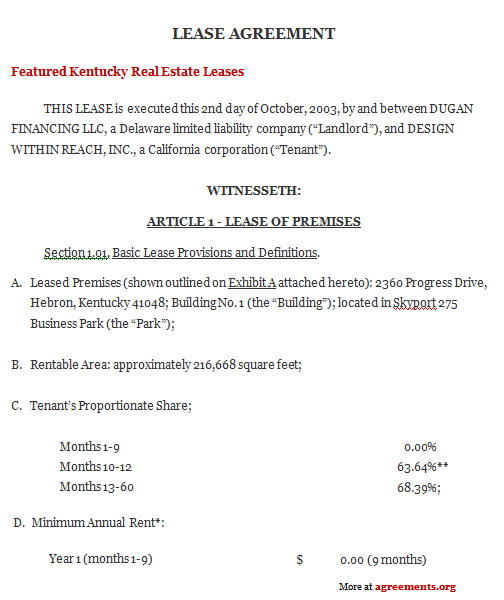What Is a Kentucky Lease Agreement?
A Kentucky lease agreement is an agreement that is created when a property is leased out in the state of Kentucky. The agreement is made between the owner of the property (known as the lessor) and the person who wishes to rent it out (known as the lessee). The agreement must contain all the details that are important to the transaction.
When Do You Need a Kentucky Lease Agreement?
This agreement is needed whenever any property is being leased out by a person. This applies to residential or commercial property. A Kentucky residential lease agreement is created when a residential property is rented out by the owner.
The purpose of this agreement is to provide a framework for the lease and to make sure that the rights of both parties are protected.
Inclusions in the Kentucky Lease Agreement
This lease agreementLease Agreement should contain all the important terms related to the lease. This includes the names and addresses of both parties, the term of the lease and the date on which the contract comes into existence.
The amount of rent and security deposit must also be mentioned in the contract. Unlike other states, there is no maximum limit for the security deposit in the state of Kentucky.
The contract must also include a description of the leased premises along with the duties and responsibilities of both parties. Which party is responsible for maintaining the property and paying for the utilities must be clarified in the agreement itself in order to avoid a dispute in the future
In simple terms, it should contain the following terms
- Details of both the parties
- Details of the property for rent
- The purpose for renting and restrictions on the use of the property
- Details of utilities provided by the landlord and the ones for which the tenant has to pay
- Details of the lease including the duration and types
- Payment schedules and the modes of payment
- Penalties and fines for the late payment
- Security deposit and advance payment
- Possession and access of the property
- Pre move-in inspection
- Assignments and successions
- Maintenance, repairs, and alterations
- Termination including premature closure and abandonment
- Permissions regarding guests, pets, noise, parking, waterbeds, or other things
- Disclosures of lead paints, asbestos, prior history of paint and repairs — anything that could impact the decision of the buyer
- Warranties and representations
- Governing law and dispute resolution
How to Draft a Kentucky Lease Agreement?
The following are the steps to follow while drafting an agreement:
- All the important terms must be decided by the lessor and lessee and thereafter be laid down in a written agreement.
- The parties can also use a Kentucky lease agreement form or a Kentucky lease agreement template and fill out the important particulars.
- The agreement must then be signed by both parties to make it a legally binding one.
- The parties must first decide the term of the lease.
- They shall then decide the rent amount, the amount of security deposit and all the other important details.
- All these decided terms must be laid down in a written agreement.
- The agreement must protect the rights of both parties.
- The agreement must be signed by both parties.
- They should agree on details such as guests, pets, parties, smoking, noise/waste
- Treatment of hazardous waste
- Alterations and permissions for assignments and successors
- Grace period for payment of rent
- Disclosures for the buyer
- Fees, payments, and other costs and the responsibility to bear such costs
- Registration and payment of statutory fees including statutory compliances
- The purpose of utilizing the lease and restrictions on what it can be used for
Benefits of the Kentucky Lease Agreement
The following are the benefits and drawbacks of this agreement:
- This agreement serves as proof of the terms and conditions under which the property has been leased out to the lessee.
- It helps protect the rights and interests of both parties.
- In case the lessee causes any damage to the property or violates any of his obligations or duties under the agreement, the lessor will have certain remedies in place.
Key Terms in the Kentucky Lease Agreement
The key terms in this lease agreement are as follows:
- Description of the premises
- Term of the lease
- Rent amount
- Amount of security deposit
- Default on rent payment
- Maintenance of property
- Events of default
- Remedies in the events of default
- Termination of agreement
What Happens in Case of Violation?
Whenever a lease agreement is violated by any party, the non-breaching party can serve a notice to the breaching party and ask for the breach to be cured within a particular period of time. In case this is not done, the non-breaching party has the option of terminating the agreement. The lessor can take back possession of his property in case the lessee fails to fulfill his obligations under the agreement.
This agreement allows a lessor (landlord) to lease residential property to a lessee (tenant) in exchange for regular payments. You can use a Residential Lease to explain all the rights and obligations of a landlord and tenant or refer to a Kentucky Lease Agreement.
Sample Kentucky Lease Agreement
You can download a Kentucky residential lease agreement template here.
